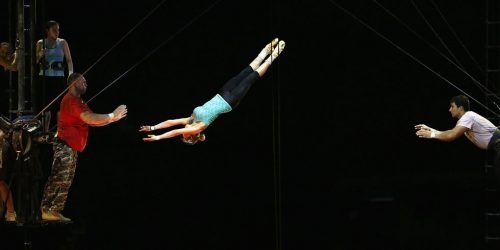Cirque du Soleil is on Broadway for the first time ever. Cirque’s new show, Paramour, opened May 25, giving the world’s most famous theater audiences a chance to experience the pit-in-your-stomach thrills of watching the chic circus’s acrobats fly through the air. Audiences can rest reassured that everyone’s safe. Right?
To find out, we spoke to Brett Copes, the head rigger of Fight or Flight Entertainment, who’s spent the last decade flying performers in shows like Cirque du Soleil’s O and Iris, and Marvel Universe Live.
As it turns out, Copes says, gravity-defying circus work used to depend mainly on “practical testing” and passed-down knowledge—basically, lessons learned from the 250 years of trial and error that started with the inception of the modern circus. Early riggers also borrowed principles from other precarious fields, like mountain and rock climbing, which existed long before aerialists took to the trapeze and high wires.
It wasn’t until the 21st century that scientists really started studying the physics and mathematics behind acrobatics. Today, Copes’s work is quite scientific. He knows, for example, that, at 6 feet and 180 lbs., our podcast host can generate up to a thousand pounds of force on even a short fall. Copes uses that knowledge to design equipment based on a “design factor,” a sort of ratio of risk that he’s willing to take. A 2:1 design factor, for example, would mean hanging our host with equipment able to hold 2,000 lbs. In practice, Copes prefers an even more robust margin of error—a design factor of 5:1 or even 10:1.
Cirque du Soleil’s Paramour sets are a mix of old school and new, a mishmash of very traditional rope-and-pulley rigs alongside computer-operated winches that cost tens of thousands of dollars. That’s how the best acrobatic rigging teams are constructed: with the wealth of knowledge and cutting-edge technology that comes from mixing old circus riggers with trained engineers and computer programmers, all united by a single, very important factor: The amount of risk they take really has a direct effect on the performer.
To hear more from about rigging, check out the How Your World Works podcast, available now on iTunes.
{ SOURCE: Popular Mechanics | http://goo.gl/HJcT7h }
